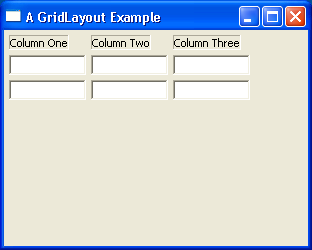GridLayout Example 2

import org.eclipse.swt.SWT;
import org.eclipse.swt.graphics.Image;
import org.eclipse.swt.layout.GridLayout;
import org.eclipse.swt.widgets.Display;
import org.eclipse.swt.widgets.Label;
import org.eclipse.swt.widgets.Shell;
import org.eclipse.swt.widgets.Text;
public class GridLayoutExample2 {
Display d;
Shell s;
GridLayoutExample2() {
d = new Display();
s = new Shell(d);
s.setSize(250, 250);
s.setText("A GridLayout Example");
GridLayout gl = new GridLayout();
gl.numColumns = 3;
s.setLayout(gl);
final Label l1 = new Label(s, SWT.BORDER);
l1.setText("Column One");
final Label l2 = new Label(s, SWT.BORDER);
l2.setText("Column Two");
final Label l3 = new Label(s, SWT.BORDER);
l3.setText("Column Three");
final Text t1 = new Text(s, SWT.SINGLE | SWT.BORDER);
final Text t2 = new Text(s, SWT.SINGLE | SWT.BORDER);
final Text t3 = new Text(s, SWT.SINGLE | SWT.BORDER);
final Text t4 = new Text(s, SWT.SINGLE | SWT.BORDER);
final Text t5 = new Text(s, SWT.SINGLE | SWT.BORDER);
final Text t6 = new Text(s, SWT.SINGLE | SWT.BORDER);
s.open();
while (!s.isDisposed()) {
if (!d.readAndDispatch())
d.sleep();
}
d.dispose();
}
public static void main(String[] argv) {
new GridLayoutExample2();
}
}
Related examples in the same category